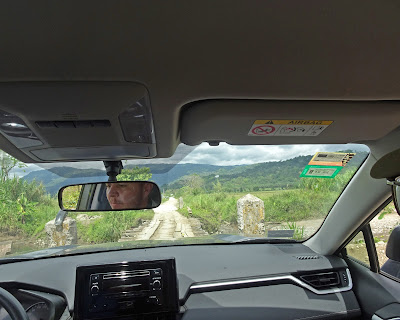Monday, January 16, 2023
Today was a departure day, so we placed our luggage outside the room by 6:00, had breakfast at 6:30, and went down to the beach for our 7:15 departure. Our large arrival group was going in two different directions this morning, so instead of the larger boat that we arrived on, we had a smaller boat going out. We saw a couple of nice birds on our walk down to the beach.
Getting back onto the boat was the opposite of our wet landing. We waded out into knee deep water and then sort of butt-slid over the side of the boat. The water was very choppy and everyone got pretty wet. We bobbed around in the surf for about ten minutes wondering why we weren't leaving, and it turned out that the Casa Corcovado guide that was to accompany us was late! He finally arrived and off we went.
Like the arrival trip this was mainly transportation with limited sight-seeing, but we did see a few Brown and Blue-footed Boobies in the ocean.
Once we'd turned back in to the much calmer Sierpe River, Johan spotted a big troop of Central American Squirrel Monkeys moving in the trees alongside the river and we stopped and watched them for a while. Squirrel Monkeys are the smallest of the Costa Rican monkeys and they were moving steadily up the river. There were at least 50 in the troop and it could have been 100.
- A
squirrel monkey tail is not prehensile, that means they cannot use it to
grab onto things. They use it for balance, nothing more.
- They are
considered to be one of the cleverest monkeys due to having a large
brain compared to the size of their body.
- These
groups consist of both male and females and can range in numbers anywhere
between 25 and 500! The only time the group splits up is when they’re
hunting for food.
We landed back at the dock where we'd left our vehicle, gathered our luggage and headed out. We gave one of the hotel boat captains a ride to town so that he could catch a bus, and then continued on to some rice fields and agricultural areas where we found some good birds.
This area of Costa Rica is archeologically significant because of "Bolsas de Piedra", or Stone Balls. Over 300 stone spheres have been discovered scattered throughout the region, and they range in size from a few centimeters up to two meters (over six feet!) in diameter. The spheres are attributed to a now extinct Diquís culture. They are thought to have marked important routes or locations, but their exact significance remains uncertain.
We visited a small park that had a few of the spheres on display.
We then did some birding around some rice fields near the town of Niely, which gave us a chance to see some wetland birds like Northern Jacana and Southern Lapwing.
We also saw a Lesser Yellow-headed Vulture, which looks very similar to our Turkey Vulture, but with hints of yellow in the head.























Those spheres are amazing to me. I've never heard of them or the Diquis culture. A new mystery to me! As usually happens, now that I have heard of them mentions will pop up and I'll wonder if the mentions have been there all along and I never noticed. This has sounded like a little bit of an unsatisfying week in some ways. Hope the next stop is marvelous!
ReplyDeleteIt was another great day. The weather was very nice so getting wet on the boat wasn’t a problem. Another day of monkeys! Definitely not something we see at home.
DeleteThat sphere is amazing. I love the look of the red breaded meadow lark.
ReplyDeleteThe spheres were really hard to get our head around! It is believed they are from a time period between 200 BC and AD 1500.
ReplyDelete